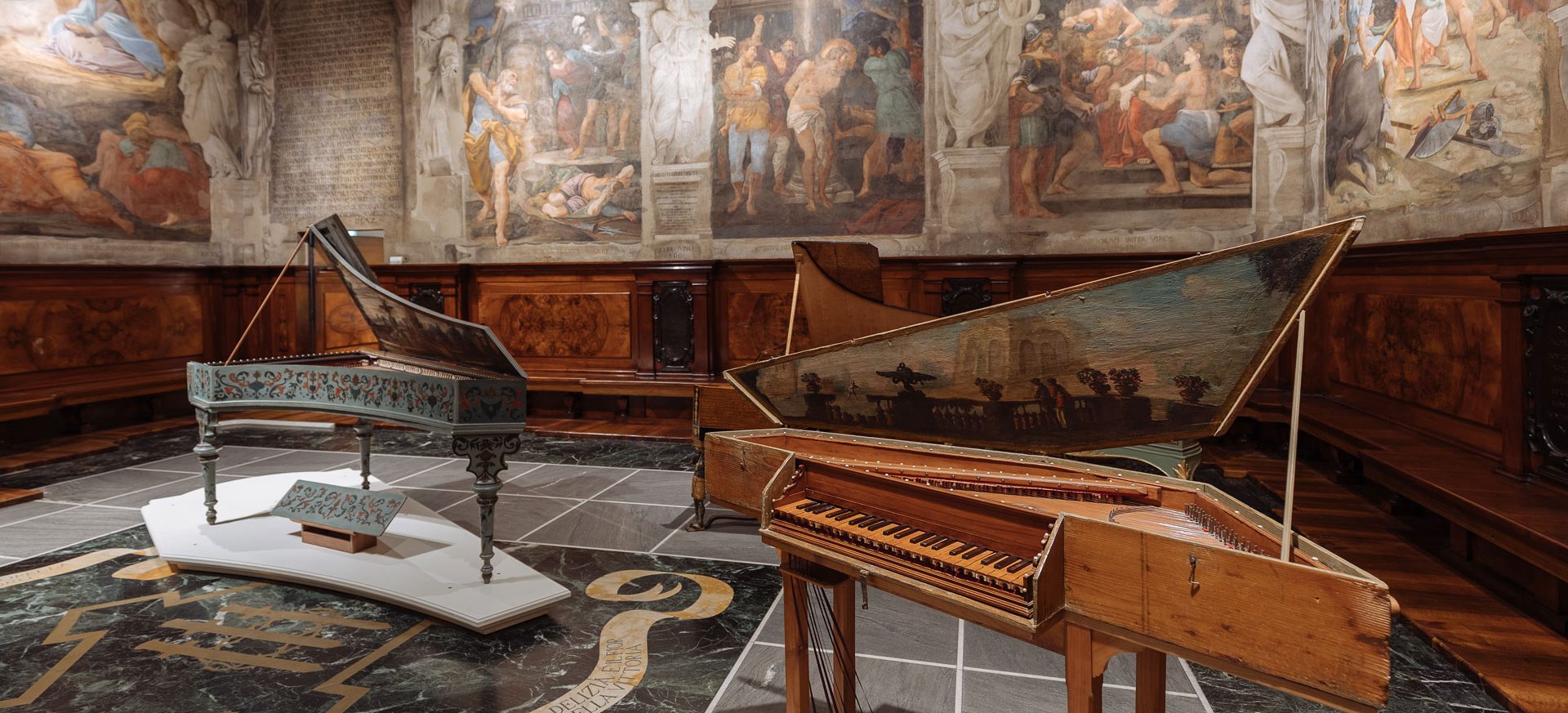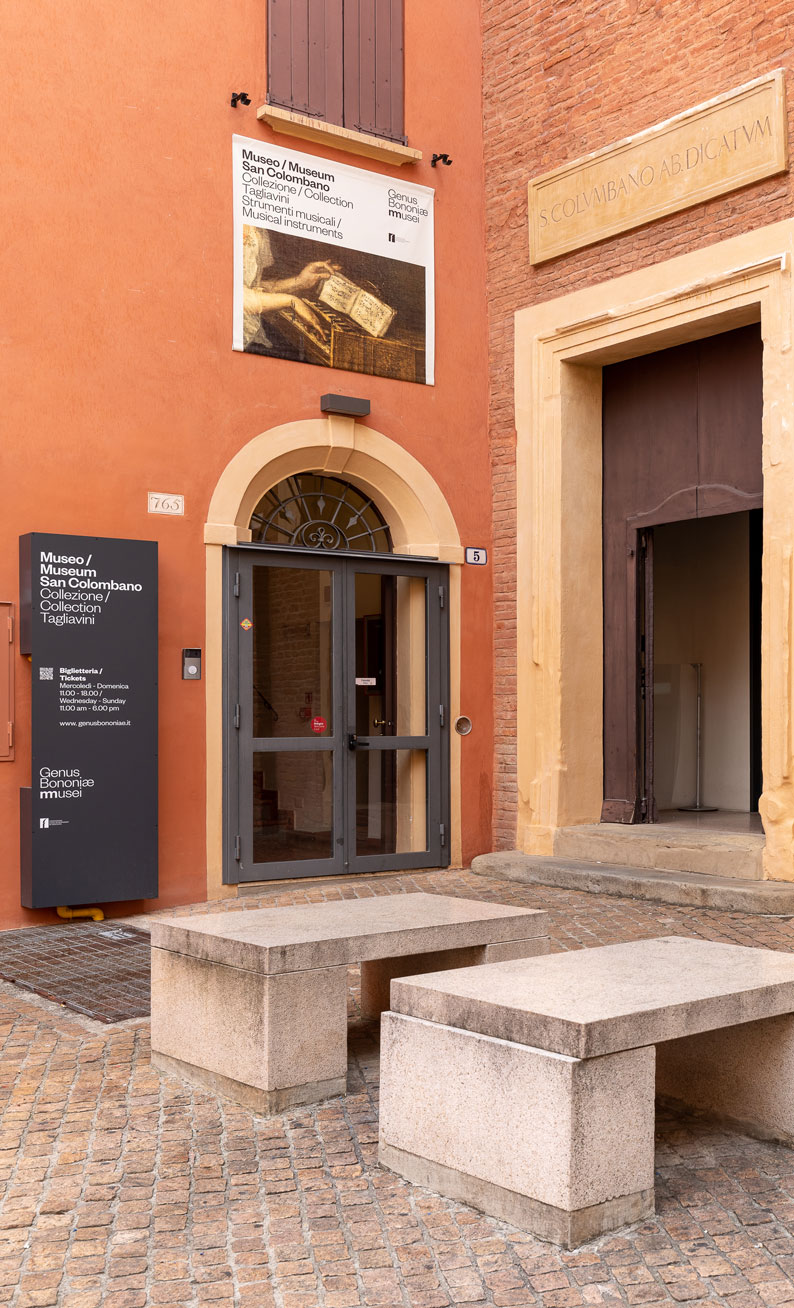
San Colombano
Tagliavini
Collection
Harpsichords, harpsichords, organs, clavichords, spinets, pianos, a collection of ancient wind and folk instruments, and a group of automatic instruments, all in perfect working order: the Tagliavini Collection of ancient musical instruments, located between the former church and the oratory, on the first floor of the complex, is undoubtedly a unique treasure on an international level.
The collection’s history began in 1969 when Maestro Tagliavini purchased a 16th-century spinet he found in Bologna, followed by the grand three-register harpsichord built in 1679 by Giovanni Battista Giusti of Lucca. It is still considered one of the most important pieces in the collection.
Among the curiosities is a 16th-century Neapolitan spinet that belonged to the Cenci Bolognetti family, the family of Beatrice Cenci, a tragic heroine who has inspired figurative, literary, and cinematic works. She was prosecuted for patricide and executed in 1599 at the age of 22 in the piazza of Castel Sant'Angelo in Rome.
A true rarity is the 1685 harpsichord by Mattia De Gand, a builder of Flemish origin who worked in Rome in the late 1600s and early 1700s. The painstaking restoration and in-depth study guided by Maestro Tagliavini revealed that the instrument was originally a one-tone transposing instrument, a true exception in the panorama of Italian harpsichord art of that time.
Every year, from September to May, San Colombano hosts a rich concert season aimed at showcasing the priceless instruments of the Maestro Luigi Ferdinando Tagliavini Collection. These instruments take centre stage in concerts, serving as witnesses to a valuable musical heritage that continues to influence the present and is a constant source of artistic inspiration.
The programming alternates between the performance of ancient and classical music, with a special focus on Renaissance and Baroque repertoire, and contemporary music. It also embraces experimentation and cross-pollination between ancient and modern music, dance, and performance, and explores synergies with other Genus Bononiae venues, paying tribute to the exhibitions hosted at Palazzo Fava and the circuit’s artistic heritage, offering new possibilities for enjoyment and interpretation.
The season also includes moments of study and in-depth exploration of traditions through numerous masterclasses held by specialists in the performance of ancient keyboard instruments, attracting participants from around the world.
Via Parigi 5, Bologna
From Wednesday to Sunday
11:00 am - 6:00 pm
Closed from Monday, August 5th to Tuesday, September 3rd, 2024.
+39 051 19936366
Bus stop Indipendenza 11 A-B-C, 27 A-B-C, 28
NAVETTA B (da Parcheggio Tanari)
BLQ (from G. Marconi Airport)
Bus stop Ugo Bassi 13, 14 A-B-C, 17, 19, 20 A-B, 25, 28, 30
For information on parking and restricted traffic zones, consult the dedicated page on the website of the Municipality of Bologna.
Full ticket | € 7
Reduced ticket | € 5
Visitatori over 70
Ticket from another Genus Bononiae Museum
Agreements
Teachers with badge
University students with badge(19-26 years old)
Journalists with badge
Reduced ticket for schools and children | € 4
School groups (+ €1 of presale)
Boys (6-18 years)
Reduced group ticket (min. 15 people) | € 5 (+ € 1,50 of presale)
Free ticket
Children up to 5 years
Visitor with disabilities
Group leader
Tourist guide with badge
Genus Bononiae Membership Card holders
Bologna Welcome Card holders
Card Cultura Bologna holders
Journalists with badge - upon request for accreditation to stampa.comunicazione@genusbononiae.it
ICOM members
Along with the admission ticket, you will receive a card that allows you to download an audio guide on your smartphone in four languages (Italian, English, Spanish, and French). It is recommended to bring your own earphones.
The San Colombano Complex is composed of a series of buildings joined together over time, beginning in the 7th century. The Church — the oldest part of the complex —was built on the orders of the Bishop of Bologna, Pietro I, around 616 A.D. It was constructed over a previous monumental structure that dated to sometime between the imperial and late-antique periods.
The building was then owned by different religious orders until its closure during the Napoleonic era.
The adjacent Chapel of the Madonna dell’Orazione was built in 1917 around an image of the Virgin, painted by the Bolognese artist Lippo di Dalmaso, which was the destination of incessant pilgrimages.
The first-floor Oratory, a true jewel of Bolognese art, was decorated by the Caracci brother’s finest disciples. It contains what Carlo Cesare Malvasia defined as the Glorious Race: a fresco cycle inspired by the Passion of Christ. During restoration work, an old crypt dating to the medieval era was discovered together with an important 13th-century wall painting attributed to Giunta Pisano, depiction Christ on the cross between the Virgin Mary and St. John the Evangelist.
Reopened to the public in 2010, the complex now houses the collection of ancient musical instruments donated by Bolognese musician and scholar Maestro Luigi Ferdinando Tagliavini, a unique collection of over 90 almost fully functional instruments acquired by Tagliavini over the decades.
The Oscar Mischiati Library includes about 15,000 items donated by Bolognese scholar Oscar Mischiati, for whom the library itself is named. In addition to books, there are repertoires, musical works, specialist organ texts (some of which are unique in Europe), periodicals, monographs, CDs, tapes, vinyls, concert programmes and book reviews. It is possible to check the online catalogue and access the volumes by contacting the Art and History Library of San Giorgio in Poggiale at the phone number: +39 051 19936352.






Discover all the Museums >
